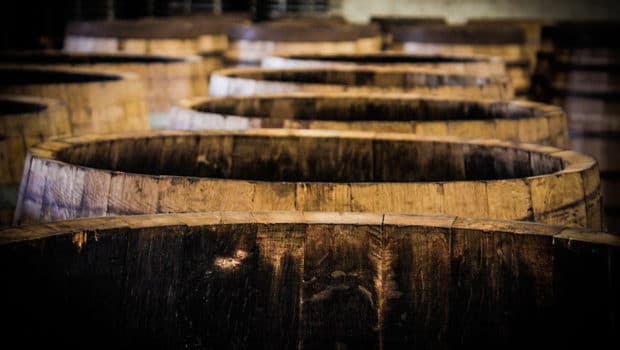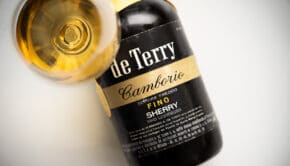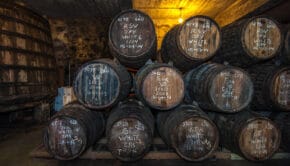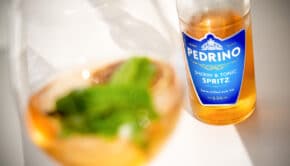Sherry and oak
I was inspired by the article Jamie on: oak, written by the excellent wine blogger Jamie Goode, in which he talks about the impact and influence of oak throughout the ageing process of sherry. He talks about the flavour impact of new wood in normal winemaking and the fact that the sherry industry prefers neutral barrels. He also talks about an oak barrel being the perfect breathing container for sherry (taking in oxygen and loosing alcohol and other elements). And then suddenly the article came to an end, and I kept thinking: is the influence of the oak that limited, really?
In the last paragraph Jamie talks about the whisky industry and the fact that sherry casks are high sought after for whisky maturation. I know a thing or two about whisky (see WhiskyNotes) and the fact that he goes over this so quickly, and leaves out essential information, made me write my own article about the influence of oak on sherry.
Effects of oak maturation
Let’s start with some background information on oak maturation in general. My knowledge mainly comes from what I know about whisky, an area in which plenty of research is available. However what I’m about to tell is true for all oak aged spirits (brandy, rum, mezcal, some liqueurs…) and wine (to a lesser extent).
Four fundamentally different effects are at play when ageing an alcoholic liquid in an oak cask:
- Additive effects of the oak
The liquid extracts components from the oak, either directly or through decomposition of wood molecules. When oak is heated in the cooperage (to make the staves more malleable), the sugars in hemicellulose caramelize and break up to form volatile aroma compounds like furfural (almonds), maltol (toast), cyclotene (caramel). The same occurs with lignin that breaks into aldehydes and phenyl ketones (vanilla), guaiacol (smoky), eugenol (clove) and other aromatic compounds. Then there is also a list of wood extractives like lactones (oaky coconut), polyphenols (tannins among others), terpenes, lipids, acids etc. All these aromas are mixed into the liquid. The type of oak plays a big role, for instance Quercus Alba (American white oak) has more dominant vanilla / coconut aromas, whereas Quercus Robur and Quercus Petraea (European oak) usually have more spicy components and more tannins. - Subtractive effects of the oak
The toasted or charred layer on the inside of a barrel removes undesired compounds by carbon filtration and oxidation reactions with the spirit, as well as absorbing compounds in its pores. - Interactive effects
Cross-reactions between various organic substances already present in the liquid, like esters, acids, fusel oils, etc. and compounds from the oak. This is where new aromas can emerge. - Oxidation
Not a direct effect of the wood itself, but as wood is not airtight, it will slowly but continously breathe through its pores. This makes it possible for constituents to interact with the air chamber inside the cask, as well as with the air outside: This causes slow oxidation and evaporation of volatile compounds, including water and alcohol (merma or angel’s share).
Whisky in oak casks
Scotch whisky is commonly matured in re-used casks that served to mature other spirits before the whisky goes in. The vast majority is acquired from the American whiskey industry which can only use new oak casks by law. This also means casks can be used multiple times to mature whisky (“first-fill”, “second-fill”…), getting less active with each subsequent use. After two or three fills, a cask can be rejuvenated, which means it is scraped on the inside (to get a new layer of active wood cells on the inner surface), toasted or charred and filled again. New oak is sometimes used, but often just for “finishing” (giving whisky a second, shorter maturation in a different cask type).
For whisky, it is generally said that 60-80% of its final taste comes from the cask. The ideal point for bottling the spirit would be the moment when the additive and subtractive processes form a harmonic balance: undesired compounds should have been filtered out and there should be a perfect mix of the original spirit and the character of the oak. The age of the cask, the size, the toasting / charring level… are some of the parameters that define the speed and overall effect of the cask.

Now onto sherry maturation and oak
When you translate the effects of oak maturation to winemaking in general, they will be generally the same, only the timing and the proportional intensity will differ. As wineries tend to use new oak, the additive effects will be much more active. Vanilla compounds, spices and especially tannins will be more noticeable after a much shorter timespan. A wine can be mature, robust and well-oaked after one or two years in a cask, whereas whiskies can be stored in refill casks for over 30 years and still not show dominant woody notes. On the other hand subtractive effects and oxidation will be lower in wine than in whisky maturation.
Sherry maturation is different, and perhaps it has more in common with whisky maturation than with regular wine maturation. Here’s why:
Old, inactive casks
First of all, the sherry industry doesn’t use new oak casks in soleras, only during the fermentation of the musts (but most bodegas have abandonded this practice in favour of fermentation in steel tanks). The wood tannins help the fermentation and improve the young wine but they are avoided for the long-time maturation of wines (also because tannins tend to be counterproductive for a healthy flor). New oak casks tend to be used for around 10 years before being included in a solera system.
This means the oak will have lost most of its additive and subtractive effects on the liquid. At the same time it will have soaked up some of the flavours of the wines that go in first. You could say it has been ‘seasoned’ (envinado) before the actual sherry goes in.
The sherry region doesn’t just avoid new oak to store wines, they treasure their casks and will only dispose them if they are beyond repair (and even then some staves may be recycled). Casks are easily used for 50 years or more. Some of the oldest casks still in use in Jerez (e.g. the ones used to mature the Amontillado 1830 from El Maestro Sierra) are almost 200 years old without ever been emptied! It goes without saying that these casks are highly inactive in the sense that they have hardly any effects from the list above. In fact, many of the casks in sherry cellars are ‘dead wood’ in a way.
A natural, breathing container
The primary effect of a good sherry cask is to provide the right amount of breathing. It controls the oxidation of Oloroso but it’s even more important for the biological ageing of Manzanilla and Fino. Flor consumes oxygen so the right amount of air contact is crucial for its development. During the fermentation phase the flor works anaerobically, but once all the sugar has been consumed, the physiology of the yeast changes and starts an aerobic process of breaking down compounds and producing others such as acetaldehyde.
Equally important is the fact that a natural container made of oak provides an ideal environment for yeasts and certain bacteria. Each cask will have an individual personality and often a specific tendency towards certain yeast strains. Emptying them or cleaning them would erase their unique biological ‘memory’ and can totally change the character of the wine it produces.
This all leads to sherry bodegas almost exclusively using white oak from North America to create their barrels. This type of wood is widely available (read: cheap), it is soft and easy to work with, it doesn’t leak easily and it has good breathing characteristics. Also it is low in tannins – tannins are not beneficial for the development of a healthy flor.
In the past there was some experimentation, for instance after World War II when they used a lot of European oak brought in from Galicia (North of Spain) or even chestnut wood which was cheaper and easier to get. Also Latin American oak (from Costa Rica and Panama among other countries) has been used. Although you can still find some leftover casks from this period in bodegas, they were all deemed inferior to American white oak.
Conclusion
Coming back to the article by Jamie Goode, when I saw the title I assumed it would give a list of positive effects of oak on sherry wines. It doesn’t. Not because it’s a bad article, but because oak has less importance in sherry production than it does in the maturation of other oak-aged spirits and wines. For sherry maturation most of the effects of oak are simply avoided or at least minimized. An old Amontillado can show vanilla, and Oloroso often has some spicy notes that can come from the oak, but sometimes only after decades of ageing.
It may be a little disrespectful, but sherry bodegas simply need a breathing container, relatively cheap and easy to repair. Other than that, the wood has relatively few effects on the wine inside, it merely facilitates other processes.

But they say sherry casks are highly sought after?
That’s true, but not necessarily the casks we see lying around in bodegas. The casks that go into the whisky industry need to be more active than the solera casks used for the maturation of sherry. Until the 1980s, the whisky industry primarily used transport casks, relatively new casks that were filled with sherry and shipped to the UK. The motion of the ship made them soak up a good deal of sherry. Once in Scotland, it was cheaper to sell them to the Scots than to take empty casks back to Spain.
Since 1986 (when Spain entered the European Economic Community) shipping sherry in cask is not allowed any more so whisky distilleries are ordering bespoke casks, made from new American oak or European oak in one of the cooperages around Jerez, where they are sent to bodegas which fill them with fermenting must and / or with a lower-grade sherry, usually Oloroso or PX (although the specific type is fairly irrelevant compared to the type of wood).
This seasoning process takes between six months and two years and ‘optimizes’ the wood: the sherry will extract most of the unwanted oak elements (tannins and heavy aromatics) and the oak will absorb some of the flavours of the sherry. After the seasoning, the sherry is often too rough and woody to enter a solera so it is usually distilled into sherry brandy or turned into sherry vinegar. After seasoning the characteristics of the cask will be similar to those of a transport cask from the past.
Bespoke sherry casks for the whisky industry
However this kind of bespoke ‘whisky industry’ cask is clearly different from a ‘sherry industry’ cask, and although some sherry bodegas are also taking care of the seasoning process, both activities are overlapping only for a small part. Most of these casks played a very small role (if any) in the maturation of proper sherry. There are just a few examples of whiskies matured in old bodega casks taken straight from a solera (for instance Bruichladdich, Tomatin, Glengoyne and Slyrs have worked with ex-solera casks), but in my opinion the results are not necessarily better (not to mention the fact that they are more expensive).
In short, sherry maturation and whisky maturation require different casks. Both are being called ‘sherry casks’ (a lack of better words really) but they have a totally different purpose.
Update November 2017:
I’ve written a more elaborate article on sherry casks in the whisky industry











